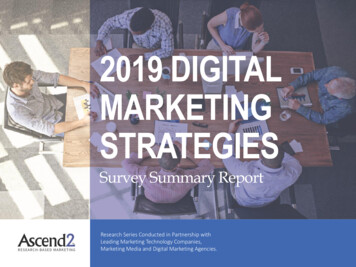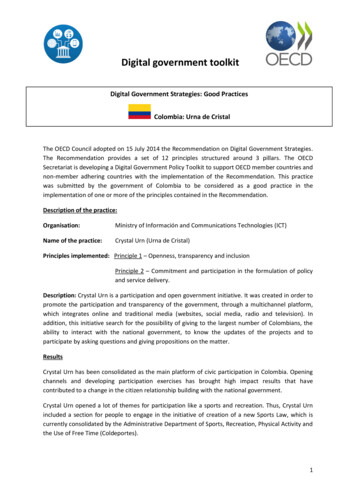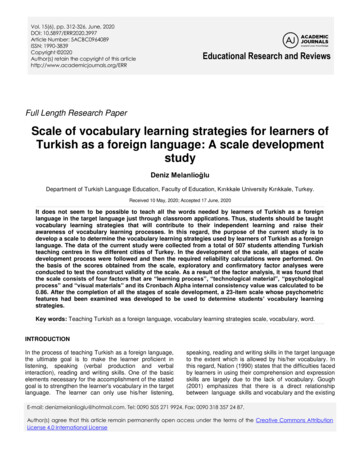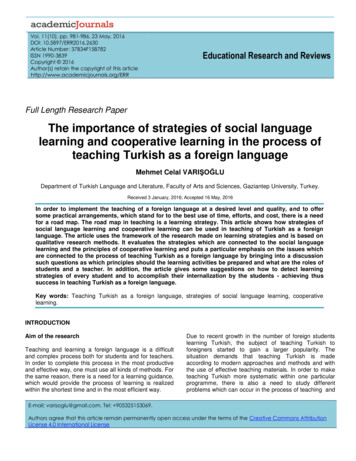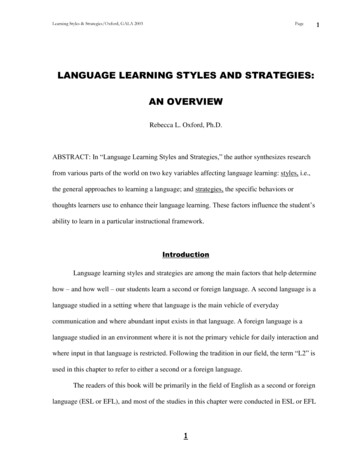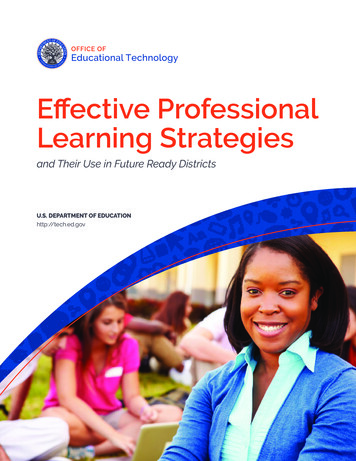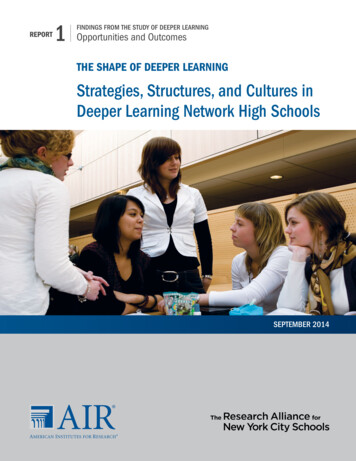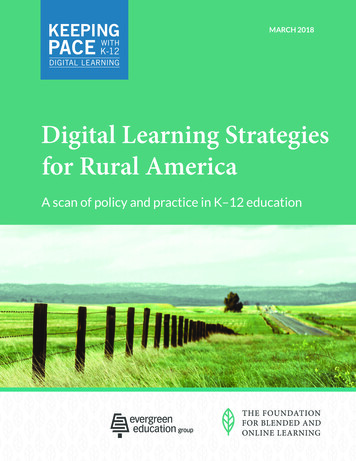
Transcription
MARCH 2018Digital Learning Strategiesfor Rural AmericaA scan of policy and practice in K–12 education
About The Foundation for Blended and Online LearningThrough scholarships, grants, original research, and strategic partnerships with adiverse cross-section of leaders, the Foundaion for Blended and Online Learningis working to close the gap between the pace of technology in daily life and thepace of change in education. By documenting and sharing their stories, our effortsto keep the student, parent, and educator experience central to the conversationsabout the future of education help ensure that “school” effectively serves alllearners and students can achieve their unique and unbounded potential. Learnmore at www.blendedandonlinelearning.orgAbout Evergreen Education GroupThe Evergreen Education Group provides a range of advisory, research, andanalysis services to non-profit organizations, government agencies, and companiesthat are leading digital educational innovation. Our policy and market researchhas helped lay the groundwork for the growth of digital learning and informslegislators and other policymakers about the latest developments in the field.Suggested citationThe Foundation for Blended and Online Learning. 2018. Digital Learning Strategies for RuralAmerica: A scan of policy and practice in K–12 education.The Foundation for Blended and Online Learning and Evergreen Education Group. 2018.Research and writing by:Butch Gemin, Barbara Smith, Lauren Vashaw, John WatsonEVERGREEN EDUCATION GROUPChris Harrington, Elizabeth S. LeBlancINSTITUTE FOR TEACHING & LEADINGCopyright 2018 Evergreen Education Group.All marks and brands used in this document are the property of their respective owners.
ForewordFor many, discussions of rural America can summon images of rolling farmland, two-lane roads stretching on formiles, community picnics, and baseball. This nostalgia runs in stark contrast to the contemporary phenomenonof “rural America as political football” playing out on television screens each night—unemployment,addiction, hopelessness.Whether you subscribe to the Mayberry or the Beattyville concept of rural life, there is a common trait sharedbetween them—that a high-quality education can open a world of opportunities to their children.Just as Canada responded to the educational needs of remote students throughout its Provinces—first throughcorrespondence courses, today through online courses—the United States, too, has begun to level the playingfield of quality curricula and educational opportunities for students across the country via digital learning.State-led initiatives to bring broadband access to schools regardless of location, the creation of high-qualityopen educational resources, and greater awareness of innovative course access programs have all contributedto the academic achievement and future prosperity of today’s rural students.This report explores the many ways rural states and schools are integrating digital learning into their portfolioof educational opportunities to secure a better future for their children and communities.Amy ValentineExecutive DirectorThe Foundation for Blended and Online LearningDigital Learning Strategies for Rural America: A scan of policy and practice in K–12 education3
I N T RODU C T ION A N D HOW TO R E A D T H I S R E P ORTRURAL AMERICA HAS ALWAYS HELD AN OUTSIZED INFLUENCE ON HOW WE SEE OUR COUNTRY,from the earliest days of the country, with its founders’ focus on farmers, to the influential role of the westernfrontier in the country’s development. In recent years, the common narrative around rural America has shiftedfrom being largely positive and even mythical, to a greater emphasis on the challenges of rural regions of thecountry, including the lack of economic opportunity for rural residents. The shifting economy’s ever-decreasingreliance on physical labor is a current topic, as rural regions are bearing the brunt of economic forces beyondtheir control. With the economic shift in rural areas towards jobs that require greater levels of learning,education is increasingly seen as part of the problem, and a necessary part of the solution, to increasingeconomic and social opportunities in rural regions.Among advocates for rural people and regions, technology is often seen as a driving factor that is shiftingeconomic activity and power from the rural heartland to urban and coastal areas. Perhaps this is a reason thatthe power of technology to address rural education challenges has been too often overlooked by many ruraladvocates. Technology in the form of online and blended learning has been helping students and schools inmany ways. Although many educators understand this, the role of technology has not been front and centerin discussions about how to improve rural education, and how to advance the college and career prospects forstudents attending rural schools. Many reports on rural education give little attention to digital learning. Atmost, they tend to note either infrastructure needs or the potential of remote course access, with little focus oninstruction, outcomes, or exemplars.1This report intends to begin correcting that imbalance by connecting the dots between rural regions, ruraleducation, and digital learning. In the introductory sections, we explore what “rural” means, and how tocharacterize rural education. Although most people have a gut-level understanding of the term rural, mostfind it is actually quite hard to define. In subsequent sections, we explore rural education issues, the ways inwhich rural schools and students are challenged by issues related to being remote, and then the ways in whichonline and blended learning can help address these challenges. Finally, we profile 15 states and programs todemonstrate policies, districts, and schools that are using digital learning to meet rural education needs. Theprofiles are each written as stand-alone case studies, and can be read independently of one another based onthe interests of each reader.Throughout the report, we use the terms online learning, blended learning, digital learning, and educationaltechnology. These terms are defined and characterized in the text box on the next page. We stress, however,that the successful, scalable use of technology in schools always uses teachers, mentors, and other caring adultsin critical roles. The technology extends the ability of teachers to reach students in new ways, and sometimesacross long distances, but it does not replace teachers. Even in these schools using online learning, teachers stillmatter more than technology. Relationships matter more than digital tools and resources. However, in areaswhere schools and students are scattered and challenged by a lack of teachers and resources, technology canbe a game-changer because of its ability to bring people together across remote areas.See, for example, the “Section 5005 Report on Rural Education, Preliminary Report, December 2017, by the U.S. Department of Education. Retrieved Report-on-Rural-Education.pdf, and Leveling the Playing Field for Rural Students, November 2017, by TheSchool Superintendents Association and the Rural School and Community Trust. Retrieved from http://www.aasa.org/uploadedFiles/Policy and Advocacy/Resources/AASA Rural Equity Report FINAL.pdf.1Digital Learning Strategies for Rural America: A scan of policy and practice in K–12 education4
Definitions and characterizations of key termsOnline LearningOnline learning is instruction and content delivered primarily over the Internet, sometimes accompanied bysome additional communication and/or assistance by phone. A single course or an entire school may be online.Virtual learning, cyber learning, and eLearning are synonyms.Blended learningBlended learning is defined by the Clayton Christensen Institute as a formal education program in whicha student learns at least in part through online learning, with some element of student control over time,place, path, and/or pace; at least in part in a supervised brick-and-mortar location away from home; and themodalities along each student’s learning path within a course or subject are connected to provide an integratedlearning experience.Education technologyWe use the term education technology to encompass the use of computers, online tools and resources, andother types of technology including video, including classroom-based uses of technology that do not fit thedefinitions of online learning or blended learning.Digital learningDigital learning encompasses instructional practices that use digital technology to strengthen or augment astudent’s learning experience. Our use of the term is broad and not limited to online and blended, but insteadincludes instructional content, interactions, data and assessment systems, learning platforms, online courses,adaptive software, personal learning enabling technologies, and student data management systems.MethodsThe report researchers’ expertise is primarily in online and blended learning. To better understand ruralregions and rural education issues, we tapped into resources (people and documents) from the National RuralEducation Association, Rural School and Community Trust, Battelle for Kids, and regional rural organizations.We also conducted extensive web searches. Our research found that while much has been written about ruraleducation challenges, and much had been written about online and blended learning, but no comprehensivereport had attempted to connect the two.Digital Learning Strategies for Rural America: A scan of policy and practice in K–12 education5
Many people were generous in sharing their time and expertise with us, and we thank them for their generositywith us and for their work on behalf of students.Robert Currie – Executive Director, Montana Digital AcademySam Brooks – Personal Learning Supervisor, VITAL Program, Putnam County, TennesseeDebi Crawford – Virtual High School Administrator, SUPERNetPatrick Crawford – Director, Pennsylvania Leadership Development CenterJaraun Dennis – Technology Coordinator, Uinta County School District #1, WyomingSandra Eggers – Virtual Education, Florida Department of EducationAdan Estrada – Superintendent, Cimarron Municipal School District, New MexicoTraci Filiss – Founder and Director, Taos Academy Charter School, New MexicoFlorida Virtual SchoolJoe Freidhoff – Vice President, Michigan VirtualScott Graham – Superintendent of Schools, Northern Potter School District, PennsylvaniaCanyon Leigh Hardesty – Director, Project ECHO for Education, University of WyomingKaren Jez – Superintendent of Schools, Titusville Area School District, PennsylvaniaGary Lilly – Director, Bristol Tennessee City SchoolsKristie Littlefield – Executive Director, Western Maine Educational CollaborativeMalynda Maurer – Chief Administrator, Central Pennsylvania Digital Learning FoundationBradley Mitchell – Director, VirtualSCJason Neiffer – Assistant Director/Curriculum Director, Montana Digital AcademyEvan Patrick – Team Digital, ArkansasAllen Pratt – Executive Director, National Rural Education AssociationSarah Rotureau – Student Services Manager, VirtualSCLisa Russell – Team Digital, ArkansasRachel Smith – Curriculum Coordinator/Federal Programs, Piedmont City Schools, AlabamaBarry Sommer – Director of Advancement, Lindsay Unified School District, CaliforniaMark Sorensen – Founder and CEO, STAR School, ArizonaBrett Turner – Executive Director, Blended Learning Bureau, New Mexico Public Education DepartmentJoseph Vagt – PBS Blended Learning Specialist Teacher, Lindsay Unified School District, CaliforniaDan Webb – Superintendent of Schools, Everett Area School District, PennsylvaniaSarah Young – Digital Teaching and Learning Coordinator, Utah State Office of EducationAlert readers will note that we have not included Alaska and Hawaii in our maps and profiles. Although thefindings of the report are applicable to these states, many of our sources are focused on the lower 48 states.We hope to address rural education issues in Hawaii and Alaska in future studies.Digital Learning Strategies for Rural America: A scan of policy and practice in K–12 education6
19%What is rural?MOST PEOPLE HAVE A SENSE FOR THE CHARACTERISTICS OF “RURAL” AREAS, but if asked to define theterm rural, they might be challenged to do so in a precise way. This is especially true when trying to distinguishbetween exurban areas, individual small or tiny towns, and regions with very few people living widely apart. Tounderstand rural education, we must first understand the definition of rural and what characterizes rural regions.When we consider rural from the perspective of where people live, the best single source of information is the USCensus Bureau.2“For the average American, rural is anabstract concept of rolling hills andfarmland rather than a concrete definition.Thus, it can be a difficult task trying to definethe term “rural” and an even harder tasktrying to explain it.” (U.S. Census Bureau)Urbanized areas and urban clusters: 2010 The Census defines rural as any population,housing, or territory not in any of the:486 Urban Areas (50,000 ppl) or3,087 Urban Clusters (2,500–50,000 ppl).23By this definition, all of the white area on themap shows rural parts of the United States.19%As of the 2010 census,19% of the population(about 60 million ppl)lived in rural areas.32Unless otherwise noted all quotes, statistics and maps in this section are from ries/index.html?appid 9e459da9327b4c7e9a1248cb65ad942a&cid 16O104.3Map from 0 UAs and UCs Map2.jpg.7
What is rural? (cont.)However, the vast white areas on the map reveal rural territory, and don’t show where most rural people actuallylive. Although we tend to think of the rural land areas in the mountains and deserts of the western US, and theexpansive plains of the mid-west, most rural populations are outside the fringes of cities. The map below showsthat most rural people live in the south and/or east, few people live in the rural regions of the Midwestern plains,and almost nobody lives within the green areas of federal land.A few counter-intuitive facts:Where people live in rural areas64%9047%%of rural Americanslive east of theMississippi River.of the total populationof the West lives inurban areas.of all Americans livingin rural areas are in theSouth region.Census Regions of the United StatesFEDERAL LANDSCOMPLETELY URBANCONCENTRATION OFRURAL POPULATIONlowestDigital Learning Strategies for Rural America: A scan of policy and practice in K–12 educationhighestWESTNORTHEASTMIDWESTSOUTH8
What is rural? (cont.)The population, of course, is not static as people move between urban and rural areas. Over the last century almostall the population growth in the United States has been in urban areas, and the rural population as a percent of thetotal population has dropped from above 60% to about 20%, while remaining about the same in total numbers.US rural and urban population20080%18070%16050%12010040%8030%Percent of PopulationPopulations (in millions)60%1406020%44010%200TOTAL URBAN POP.TOTAL RURAL POP.19001910192019301940195019601970198019900%% OF POP. IN URBAN AREAS% OF POP. IN RURAL AREAS4National Assessment Synthesis Team, Climate Change Impacts on the United States: The Potential Consequences of Climate Variability and Change, US Global Change Research Program, Washington DC, 2000. Retrieved .pdf.4Digital Learning Strategies for Rural America: A scan of policy and practice in K–12 education9
Rural educationTHE NATIONAL CENTER FOREDUCATION STATISTICS (NCES)builds on the Census Bureau’smethods and numbers to create aclassification of all schools basedon “locale categories.”CITYLargeMidsizeSmallSUBURBNCES assigns every school in thecountry a locale code, indicating inwhich category the school exists.The percentage of rural districts,schools, and students is similar tothe overall US population in thissense: the US rural territory is farlarger than urban territory, butholds far fewer people. Similarly,almost six in ten districts (57%) arerural, but only 24% of students areconsidered rural. In contrast, 5%of the largest city school districtseducate 29% of all students.In sum, more than half of alldistricts, a third of all schools,and a quarter of all students arerural. Within the rural categories,about 60% of rural studentsare fringe, 30% are distant, and10% are URALFringeCensus-defined rural territory that is less than or equal to 5 milesfrom an urbanized area, as well as rural territory that is less thanor equal to 2.5 miles from an urban clusterDistantCensus-defined rural territory that is more than 5 milesbut less than or equal to 25 miles from an urbanized area,as well as rural territory that is more than 2.5 miles but lessthan or equal to 10 miles from an urban clusterRemoteCensus-defined rural territory that is more than 25 miles from anurbanized area and is also more than 10 miles from an urban tions.asp.Digital Learning Strategies for Rural America: A scan of policy and practice in K–12 education10
Percentage distribution of public elementary and secondarystudents, schools, and districts, by locale: School year 2010-11FIGURE RAL5As referenced in Figure 2, the overall percentage of rural students tends to:66 Be more white than the national average (73% rural compared to 50% national average)7 Be less Hispanic (12% to 25%), and Black (9% compared to 16%), and Asian (1% to 5%)8 Be equal to the national average in terms of percentage of students with Individual EducationPrograms (12%)9 Have much lower rates of students with limited-English proficiency (5% to 9%)10 Be slightly less likely to be living in poverty (17% to 20%)11 Spending per rural students is 9,625, which is 7% lower than the national average of r p.Digital Learning Strategies for Rural America: A scan of policy and practice in K–12 education11
Student attainment in ruralschools matches city, suburb, andtowns in some ways, but not inothers.13 Figure 2 demonstratesmeasures of attainment asmeasured by the NationalAssessment of EducationalProgress (NAEP), rural studentsperformed as well or better thannational averages on reading andmath exams.14 Similarly, amongthe general population of peopleage 25 and older, about the samepercentage of people in rural areashave completed a high schooldiploma or equivalent comparedto national averages.The number of rural residentswho complete a four year collegedegree, however, is about sevenpercentage points lower than thenational average. A similar numberis found in younger people as well:the national average percentageof people age 18-24 enrolled in apost-secondary institution is 42%,while the rural average is 29%.FIGURE 2:Rural vs. National average80%7370%60%50%5040%30%2520%1210%12 12910%55WhiteHispanicBlackAsianIEPStudents Students Students Students Program209LimitedEnglishPoverty50%40%352830%3130 292220%13 1310%0%Less thanHS diplomaHS completion Some college butbut not highernot 4 yr degreeRURAL POPULATION131716Bachelorsor higherNATIONAL b.3.c.-1.asp.The Rural School and Community Trust. 20
The report researchers’ expertise is primarily in online and blended learning. To better understand rural regions and rural education issues, we tapped into resources (people and documents) from the National Rural Education Asso




